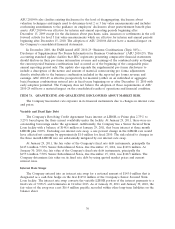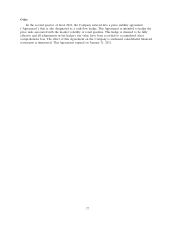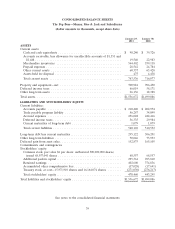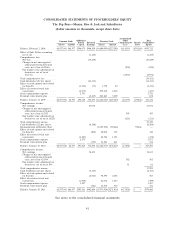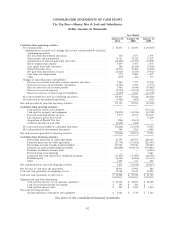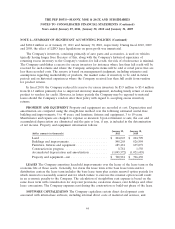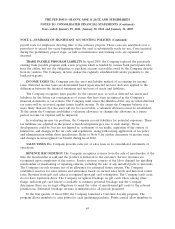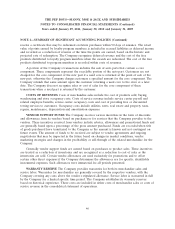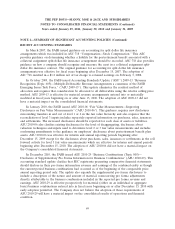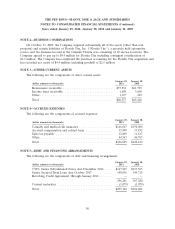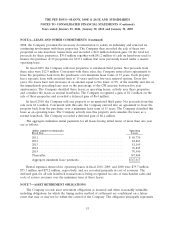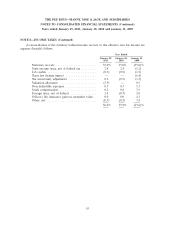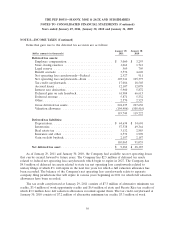Pep Boys 2010 Annual Report Download - page 104
Download and view the complete annual report
Please find page 104 of the 2010 Pep Boys annual report below. You can navigate through the pages in the report by either clicking on the pages listed below, or by using the keyword search tool below to find specific information within the annual report.THE PEP BOYS—MANNY, MOE & JACK AND SUBSIDIARIES
NOTES TO CONSOLIDATED FINANCIAL STATEMENTS (Continued)
Years ended January 29, 2011, January 30, 2010 and January 31, 2009
NOTE 1—SUMMARY OF SIGNIFICANT ACCOUNTING POLICIES (Continued)
receive a certificate that may be redeemed on future purchases within 90 days of issuance. The retail
value of points earned by loyalty program members is included in accrued liabilities as deferred income
and recorded as a reduction of revenue at the time the points are earned, based on the historic and
projected rate of redemption. The Company recognizes deferred revenue and the cost of the free
products distributed to loyalty program members when the awards are redeemed. The cost of the free
products distributed to program members is recorded within costs of revenues.
A portion of the Company’s transactions includes the sale of auto parts that contain a core
component. These components represent the recyclable portion of the auto part. Customers are not
charged for the core component of the new part if a used core is returned at the point of sale of the
new part; otherwise the Company charges customers a specified amount for the core component. The
Company refunds that same amount upon the customer returning a used core to the store at a later
date. The Company does not recognize sales or cost of sales for the core component of these
transactions when a used part is returned by the customer.
COSTS OF REVENUES Costs of merchandise sales include the cost of products sold, buying,
warehousing and store occupancy costs. Costs of service revenue include service center payroll and
related employee benefits, service center occupancy costs and cost of providing free or discounted
towing services to customers. Occupancy costs include utilities, rents, real estate and property taxes,
repairs, maintenance, depreciation and amortization expenses.
VENDOR SUPPORT FUNDS The Company receives various incentives in the form of discounts
and allowances from its vendors based on purchases or for services that the Company provides to the
vendors. These incentives received from vendors include rebates, allowances and promotional funds and
are generally based upon a percentage of the gross amount purchased. Funds are recorded when title
of goods purchased have transferred to the Company as the amount is known and not contingent on
future events. The amount of funds to be received are subject to vendor agreements and ongoing
negotiations that may be impacted in the future based on changes in market conditions, vendor
marketing strategies and changes in the profitability or sell-through of the related merchandise for the
Company.
Generally vendor support funds are earned based on purchases or product sales. These incentives
are treated as a reduction of inventories and are recognized as a reduction to cost of sales as the
inventories are sold. Certain vendor allowances are used exclusively for promotions and to offset
certain other direct expenses if the Company determines the allowances are for specific, identifiable
incremental expenses. Such allowances were immaterial for all periods presented.
WARRANTY RESERVE The Company provides warranties for both its merchandise sales and
service labor. Warranties for merchandise are generally covered by the respective vendors, with the
Company covering any costs above the vendor’s stipulated allowance. Service labor is warranted in full
by the Company for a limited specific time period. The Company establishes its warranty reserves
based on historical experience. These costs are included in either costs of merchandise sales or costs of
service revenue in the consolidated statement of operations.
46


